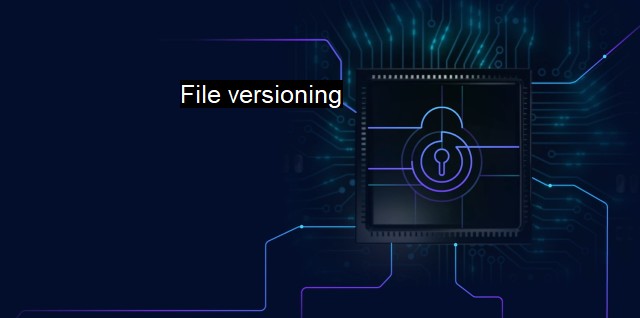What is File versioning?
File Versioning: Strengthening cybersecurity measures through preservation of data integrity
File versioning can be considered as an integral practice in the field of cybersecurity and antivirus. It is the process of storing multiple copies of the same file, each identified uniquely by their own version number. This allows users to track changes made to the file, revert back to a previous version if mistakes have been induced, and efficiently manage files without losing important data. Beyond a mere tool for efficient file organization and management, it also serves as a robust defence strategy in cybersecurity.In the cybersecurity landscape, attacks are becoming increasingly sophisticated, often targeting crucial files and documents that contain sensitive information. Perpetrators of these attacks desire to disrupt or manipulate these files, either to render them useless or transform them into potential weapons. One such attack is called a ransomware attack where the victim's files are encrypted and a ransom is demanded to restore the data. Here, a system equipped with file versioning can empower the user to restore versioned copies of the files from before the attack, thwarting ransom efforts and aiding quick recovery.
Limitations may be put in place such that access rights are defined, based on user roles or credentials. This protocol prevents unauthorized attempts of tampering, altering or deleting the file versions. Thus, an inherent part of file versioning is to ensure safety and control access in line with principles of cybersecurity.
Within the context of antivirus, file versioning can aid in the detection and repair of infected files. Sometimes, the antivirus software may not be able to fully clean a document compromised by malicious software, leaving it altered or even damaged. With file versioning, older versions of any infected files can be retrieved thus restoring the system functionalities and aiding to dislodge the virus intrusion.
File versioning system can be even more influential when integrated with other software. For instance, when combined with a backup mechanism, file versioning can allow users to take snapshots in time of their system's state. This reduced reliance on a single defensive component boosts the system’s ability to stand against threats.
a crucial aspect in security measures is the ability to track changes and actions made within a system. An aspect well integrated into file versioning, wherein each version of a file is associated with the modifications to the document along with the modifier’s details. Such role-significant tracking of changes can greatly aid in bolstering security measures by revealing potential intrusion.
While the concept of file versioning may be born out of normal data management operations, its intricate interplay with cybersecurity and anti-virus software ensures that it is not merely a passive exercise of backup storage. Rather file versioning, in its ability to continually take snapshots of files, isolate and repair corrupt or infected versions, and collaborate with defences to aid in quick system recovery, shows its importance.
In a world that's becoming more completely digitized each day, the implications of threats varying from misuse of critical data to altered documents, makes security an utmost priority. With new threats evolving constantly, cybersecurity relies heavily on advanced technological functions, and thus, encompasses file versioning as a major component amidst its multi-tiered measures. It is certainly hard to overemphasize the necessity of adopting successful file versioning practices, to ensure both security and successful progression in the volatile field of information technology.

File versioning FAQs
What is file versioning and why is it important in cybersecurity?
File versioning is the practice of keeping multiple versions of a file over time. It is important in cybersecurity because it allows you to track changes to your files and restore previous versions in case of data loss or data corruption caused by malware or viruses.How does file versioning help to prevent data loss and corruption from viruses and malware?
File versioning allows you to keep a history of changes to your files, so you can easily restore a previous version in case it gets corrupted or infected with a virus or malware. This helps to prevent data loss and ensure the integrity of your data.What tools or software can I use for file versioning in my antivirus software?
There are many tools and software available for file versioning in cybersecurity and antivirus, including Git, Subversion, and Microsoft's File History. It's important to choose a tool that suits your specific needs and use cases.How can I ensure that my file versioning process is secure and not vulnerable to cyber attacks?
To ensure that your file versioning process is secure, it's important to encrypt your files and use secure, encrypted storage for your backups. You should also implement strong access controls and regularly audit your system for vulnerabilities. Additionally, it's important to keep your antivirus software up to date and educate your team on safe file sharing practices.| | A | | | B | | | C | | | D | | | E | | | F | | | G | | | H | | | I | | | J | | | K | | | L | | | M | |
| | N | | | O | | | P | | | Q | | | R | | | S | | | T | | | U | | | V | | | W | | | X | | | Y | | | Z | |
| | 1 | | | 2 | | | 3 | | | 4 | | | 7 | | | 8 | | |||||||